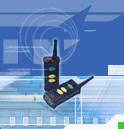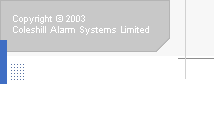Personal Attack Alarms
For every application the system is designed to provide the lone worker with a manual and an automatic
means of summoning help in an emergency.
Personal Attack Alarms
Lone Worker Safety Alarms / Radio Alarm Transmitter
Emergency Button. Each lone worker is equipped with a personal attack radio alarm transmitter clipped on to a belt.
It has a red emergency button on top which the lone worker can press to send a radio alarm signal to
the monitoring receiver. Once the emergency button is pressed, a location sounder is activated and a repeat
alarm transmission sent until both reset buttons on the unit are pressed together.
Motion Detector. For situations when the lone worker is incapacitated due to illness or injury,
the radio alarm transmitter senses the lack of movement and responds accordingly. As soon as the personal attack alarm
radio alarm transmitter is removed from its charger, monitoring of the worker commences. Lack of
movement for one minute (variable to suit different working environments) starts an alert bleep
lasting for up to 15 seconds (variable). If the lone worker fails to acknowledge the alert by tapping
the unit or pressing the pause button, a radio alarm transmission is sent and the location sounder
activated.
Pause Function. The motion detector works very well for people performing fairly active manual tasks,
however, many jobs now involve periods of static computer-based work. To cope with both situations in a
single unit, we have developed a pause function which temporarily disables the motion detector for a preset
time, say 15 minutes. This allows the worker to complete their 'static' task without being interrupted by
the alert bleep. The pause function may be cancelled manually by pressing the button a second time or
automatically when either the unit senses an increased rate of activity or when the pause period has elapsed.
Other combinations of tilt sensors and motion detectors are available for special requirements.
Recharging the transmitter. When the radio alarm transmitter is not in use, it is kept in a drop-in fast
charger. This disables the motion detector and recharges the transmitter's NiMH battery in under 2.5 hours
before switching to a trickle charge, keeping the battery topped up and ready for use.
Automatic Fault Monitoring. The transmitter can also be programmed to automatically send regular test calls which
include the transmitter's battery status. Low battery and missed test call faults are displayed on the monitoring
receiver. This continuous monitoring of the transmitter enables operational faults due to damage or component failure
to be quickly detected when the system is in use.
Personal Attack / Lone Worker Safety Alarms - Monitoring Receiver
On-site Alarm Monitoring. A radio alarm transmission will be detected and latched by a monitoring receiver located
on site, typically in a security lodge, reception or central control room. There is an audible warning and the Lone
Worker's unit is identified by a numbered light. The audible warning may be muted, however, the light stays
illuminated until the system is muted and reset, or a reset signal is received from the lone worker. The standard
range of monitoring receivers will support 2, 4 or 8 lone workers with provision for expansion up to 32. The standard
unit has 4 output relays with programmable delays which can be used to trigger external warning devices such as a
siren, flashing beacon or paging system.
External Monitoring. If there is no-one on site to respond to an alarm, the system can interface to either
a digital communicator or an automatic telephone dialler to contact a 24-hour central monitoring station or
other company sites and employees.
Demonstration and Range Tests. It is impractical to quote a standard radio range for the system as it depends on
the topography of the site, the construction of buildings and the location and height of the receiving aerial.
The 'typical' range of the system on industrial sites is in excess of 500 metres, with ranges of 2 - 3km possible
in some situations. A transceiver or aerial amplifier may be used on difficult sites to boost the system's range
or to improve reception from problem areas such as basements. As part of our free demonstration we can conduct
range tests and assess the radio performance on individual sites.
|





